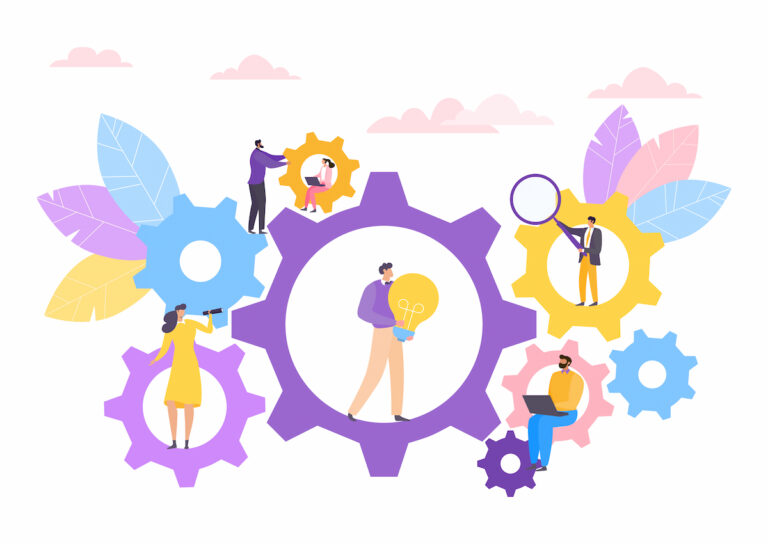Dedicated software development teams involve more than a few developers and CTOs. The high-performing team requires a diverse set of niche skills necessary for various project stages, including analysis, design, development, testing, and deployment.
Ensuring adequate resources is critically important for a project’s success and timely delivery. However, about 60% of IT projects fail due to poor team structure and insufficient recruitment efforts.
Therefore, senior management should recognize that a successful software project never comes without a well-managed and adequately trained team across various roles.
While assembling a full team can be resource-intensive and time-consuming, many businesses are now turning to dedicated software development teams as a viable alternative.
Typical team roles in software development
The composition of team roles varies between different types of teams. For example, the roles and responsibilities in a project team differ from those in a product team.
Today, we’d like to focus on the structure of an Agile product team, reflecting our company’s expertise in establishing in-house engineering teams for product-focused tech companies.
Key roles in a dedicated software development team
Product Manager
A Product Manager is usually guiding the entire development process towards a successful market launch. They have a wide range of responsibilities, including developing and executing strategies, planning and tracking product KPIs, meeting ambitious company objectives through product strategies, keeping a close watch on competitors, conducting thorough market analyses, brainstorming new ideas, and overseeing pricing policies.
Moreover, PMs act as the cohesive force within the dedicated software development team. They organise and assign tasks and maintain close communication with developers, product owners, marketing teams, sales, and all project stakeholders.
PMs coordinate meetings, ensure they run smoothly, evaluate and decide on proposals, manage technical execution, and handle documentation and maintenance processes.
Learn how to build an effective software development team: overview of crucial steps and main roles.
Product Owner
Another critical figure in a software development team is the product owner. This role is dedicated to enhancing the product’s value. To achieve this, they must understand the client’s specific requirements, set clear goals, and foster a unified vision among the team members.
Product owners often juggle multiple responsibilities, including business strategy, product design, market analysis, and project management, which can sometimes overlap with project managers and business analysts.

However, product owners focus primarily on the product’s profitability, unlike the latter, who are more concerned with the technicalities of the development process.
Key responsibilities of a product owner include developing an engaging product roadmap, managing the product backlog, serving as the main point of contact between the development team and stakeholders, assessing user feedback, and ensuring the product delivers maximum value to its users.
This role requires a unique blend of strategic foresight, effective communication skills, and a thorough understanding of both business goals and user needs.
These qualities are essential for leading the team toward the successful development of a high-quality product that is well-aligned with market demands.
Business Analyst
Business Analysts play a key role in bridging the gap between market demands and the engineering team.
They are responsible for thoroughly researching and gathering detailed information about the product, identifying the target audience’s specific needs, and analysing user behaviour and concerns.
Based on their analysis, Business Analysts draft recommendations for product enhancements and developments. Once the product is developed, they assess its effectiveness in solving market issues and evaluate its relevance and value to end-users.
Engineering Manager
These experts are closely engaged with every team member, gaining an in-depth understanding of the team’s performance dynamics.
Their role extends beyond mere management; they foster a trustworthy work environment, encouraging open communication, idea sharing, and feedback among all team members.
Engineering managers help refine the team structure, particularly when new developers join. They also play a key role in mentoring these new members. With their strong technical expertise, they choose the best engineering solutions for the product’s realisation. They are also adept at identifying and mitigating potential challenges early on using technical tools.
Software Architect
Architects are responsible for orchestrating the software’s internal structure and ensuring it aligns with the product requirements and available resources.
Deeply rooted in the business’s needs, architects delineate the technical and functional tools necessary for product development.

However, their role is not limited to planning; architects also actively participate in the development process, shaping the system’s design.
These experts possess a strategic vision, which is crucial for planning future enhancements, expansions, and integrating new features into the software.
As masters of optimisation, skilled software architects navigate through project challenges to discover the most effective technical solutions that smoothly integrate with the overall product objectives.
Software Developers
In any discussion of key roles within a software development team, software developers stand out as the keystones. These technical experts are responsible for bringing code to life using various programming languages, frameworks, and libraries.
Programmers are typically categorised into three ranks based on their level of experience:
- Junior (1-3 years of experience)
- Middle (3-5 years of experience)
- Senior developers (7-10+ years of coding)
Additionally, developers may specialise in specific areas, becoming experts as full-stack, front-end, or back-end developers. Their collaboration with other team members, including designers, testers, and product engineers, impacts the overall project success.
UX/UI Designers
User Experience (UX) and User Interface (UI) roles are distinct but closely interlinked, requiring a mix of creative flair and technical skill.
UX designers focus on making the browsing experience user-friendly and accessible.
They conduct in-depth analyses of the target audience’s behaviors to design interfaces that navigate users smoothly through the product.
On the other hand, UI designers are the visual artists who dictate the aesthetic aspects of a product. They utilise elements such as fonts, colours, shapes, and animations to create an interface that is visually engaging and intuitive to use.
While these roles are separate within the development process, it is common for one individual to fulfil both responsibilities as a UX/UI designer.
QA Engineer
QA (Quality Assurance) engineers act as the user’s advocate. They rigorously test the software to ensure it functions correctly and adheres to quality standards.
QA engineers remain engaged throughout the development process, pinpointing areas for enhancement and overseeing the testing procedures.
QA automation engineers, in particular, need a solid understanding of testing theories and methodologies, along with coding skills. They automate tests using scripts they develop, streamlining the testing process.
Following the tests, they analyse the results and produce detailed bug reports outlining the conditions leading to each bug. These precise reports are invaluable, saving time and helping developers avoid repeating the same errors.
Scrum Master
Adhering to Agile methodologies, scrum masters implement scrum techniques to effectively lead the team.
Their role is dynamic and encompasses organising daily meetings, collecting feedback, conducting individual reviews, and diligently removing obstacles that may impede the team’s efficiency and progress.
Within the Scrum framework, scrum masters are engaged in planning sprints, setting timelines, and assigning tasks for each cycle. They proactively manage the task backlog during sprints using tools like Trello or Jira.
Following each sprint, the scrum master collaborates with the development team to review and analyse outcomes, discussing challenges and achievements.
This review shapes the agenda for the upcoming sprint, perpetuating the cycle.
Testers
Testers ensure that the product functions correctly. These professionals manually lead the testing phase, carefully discovering potential defects, bugs, or issues that could frustrate end-users.
After thorough testing, they compile detailed reports with suggestions for necessary improvements.
Additional responsibilities of testers include:
- Evaluating and approving test plans
- Analysing product specifications and requirements to ensure alignment with the design
- Developing a coherent testing strategy
Technical testers on the team also take on the task of setting up test environments or offering support to network management personnel and system administrators, ensuring that all technical aspects are optimised for testing efficiency.
Team Lead or Tech Lead
In the software development process, software team roles span two critical areas: technical expertise and people management.
The tech lead, an experienced programmer, is at the helm of the technical domain.
Key responsibilities include conducting code reviews, enhancing the team’s prowess through technical leadership and mentorship, and solving practical issues that emerge during the development phase.
On the other hand, Team Leads focus on the managerial aspects.
Their primary duties involve prioritizing tasks, maintaining communication across different teams, and managing the workflow.
To effectively distribute tasks, Team Leaders need a deep understanding of each member’s role and responsibilities within the successful software development team.
They also help boost team morale and motivation, provide feedback, and handle routine administrative queries, such as those about vacations or days off. Clearly, both roles embody different facets of leadership within the team.
How Altamira can help you in hiring a dedicated development team
Every specific project is unique and requires a customized approach to ensure its success. Therefore, we assemble a dedicated team from the ground up, tailored specifically to your project scope and requirements.
By hiring our experts, you gain access to skilled talent that can build effective solutions, allowing you to scale your business and achieve sustainable growth.
We work on multi-dimensional tech roles across niche skills & domains globally:
- AI/ML Engineering Teams
- Low-code/No-code teams
- Custom-selected Software Engineering Teams
- Data engineering teams
- Salesforce & Veeva Engineering Teams
It’s high time to hire our best IT talent beyond borders and boundaries! Contact us to learn more!






